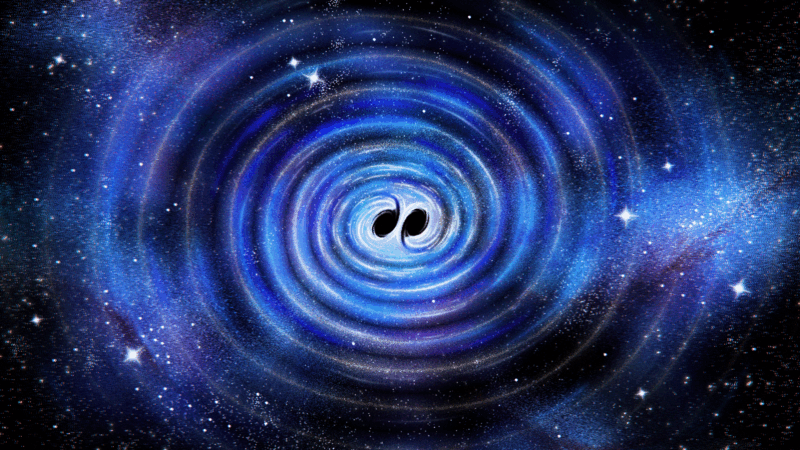After 10 years of black hole science, Stephen Hawking proven right
On September 14, 2015, physicists attained the long-sought goal of detecting gravitational waves, the shockwaves spewed out by such cataclysmic events as the violent merger of two black holes.
This huge breakthrough quickly garnered three of the effort’s key figures the physics Nobel Prize. In the ten years since then, scientists have detected hundreds of black holes coming together, as well as other extreme cosmic events like neutron stars colliding and black holes merging with a neutron star.
Now, in the journal Physical Review Letters, researchers say their ability to analyze gravitational waves has improved so much over the past decade that they were recently able to verify a key idea about the growth of black holes — one put forth by Stephen Hawking back in 1971.
“There’s a very famous statement in physics that Stephen Hawking worked out, which is that the area, the surface area, of black holes can never decrease,” explains Maximiliano Isi, an astrophysicist with Columbia University and the Flatiron Institute.
And he says that’s just what scientists observed after analyzing gravitational waves detected earlier this year. On January 14, detectors registered gravitational waves that came from two colliding black holes about 1.3 billion light-years away.
These black holes had masses between 30 to 40 times that of our Sun, so their collision was very similar to the one that led to the first gravitational wave detection back in 2015. Since that time, however, the pair of giant detectors run by LIGO, in Louisiana and Washington state, have been repeatedly upgraded.
“Because the detectors are so much better today, we can record the signal so much more clearly,” says Katerina Chatziioannou, a gravitational wave physicist at Caltech.
That allowed them to perform a new analysis showing that between the two of them, the initial black holes had a combined surface area of 240,000 square kilometers (roughly the size of Oregon). After they merged to form a single black hole, its area was about 400,000 square kilometers (roughly the size of California).
Hawking’s theory says that the final area of the black hole has to be bigger than the sum of the two initial areas, says Chatziioannou, “and this is what we demonstrated observationally with that signal.”
This kind of proof is just what Hawking hoped for a decade ago, when the first gravitational wave detection was announced. He actually reached out to one of the scientists involved in that effort to see if gravitational waves could be used to test this prediction, says Isi.
Back then, though, it just wasn’t possible because there was too much noise in the data and the analytic techniques hadn’t advanced enough.
Hawking died in 2018. “It’s unfortunate that Hawking is not around anymore, but certainly this is a way in which his legacy lives on,” says Isi.
“All of these ideas that people thought up in the 70’s, thinking it was just idle speculation, now they are manifested in actual data,” adds Isi. “We see these things happening almost exactly as predicted.”
Albert Einstein, who predicted the existence of gravitational waves in 1916, thought that they’d never be detected. “If we told him that we are detecting gravitational waves from colliding black holes every other day, or every two or three days or so,” says Isi, “I’m sure it would have been mind blowing to him.”
Overall, researchers have been surprised by how many merging black holes they have seen, says gravitational wave researcher Gabriela González with Louisiana State University.
“We have seen so many black hole mergers. We are learning so much about them that sometimes I feel tempted to call this ‘black hole astronomy’ rather than ‘gravitational wave astronomy,'” she says.
She would have predicted that they’d see far more mergers between neutron stars, but they’ve only seen a couple examples of that so far.
That could change, as researchers are already working on plans for new, even bigger gravitational wave detectors that would be ten times more sensitive. “That’s our dream,” she says, adding that in another decade, these detectors could be under construction — perhaps even completed.
Assuming researchers get the funding, that is. The current LIGO observatory, which is funded by the National Science Foundation, is facing potential budget cuts, with the Trump administration proposing steep reductions in 2026.
Auburn tabs USF’s Alex Golesh as its next coach, replacing Hugh Freeze on the Plains
The 41-year-old Golesh, who was born in Russia and moved to the United State at age 7, is signing a six-year contract that averages more than $7 million annually to replace Hugh Freeze. Freeze was fired in early November after failing to fix Auburn’s offensive issues in three seasons on the Plains.
Alabama Power seeks to delay rate hike for new gas plant amid outcry
The state’s largest utility has proposed delaying the rate increase from its purchase of a $622 million natural gas plant until 2028.
Former U.S. Sen. Doug Jones announces run for Alabama governor
Jones announced his campaign Monday afternoon, hours after filing campaign paperwork with the Secretary of State's Office. His gubernatorial bid could set up a rematch with U.S. Sen. Tommy Tuberville, the Republican who defeated Jones in 2020 and is now running for governor.
Scorching Saturdays: The rising heat threat inside football stadiums
Excessive heat and more frequent medical incidents in Southern college football stadiums could be a warning sign for universities across the country.
The Gulf States Newsroom is hiring an Audio Editor
The Gulf States Newsroom is hiring an Audio Editor to join our award-winning team covering important regional stories across Mississippi, Alabama and Louisiana.
Judge orders new Alabama Senate map after ruling found racial gerrymandering
U.S. District Judge Anna Manasco, appointed by President Donald Trump during his first term, issued the ruling Monday putting a new court-selected map in place for the 2026 and 2030 elections.









